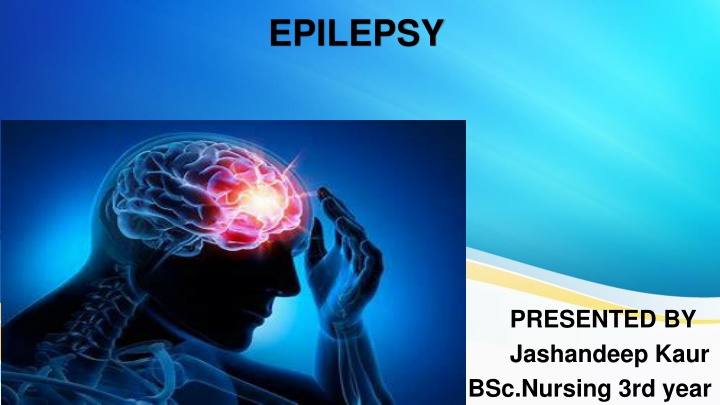
Epilepsy: Causes, Symptoms, and Treatment
Epilepsy is a chronic brain disorder characterized by recurrent seizures affecting millions worldwide. Learn about the different types of seizures, symptoms, and classification of epilepsy to better understand this condition. Early detection and proper management are essential in improving the quality of life for individuals with epilepsy.
Download Presentation

Please find below an Image/Link to download the presentation.
The content on the website is provided AS IS for your information and personal use only. It may not be sold, licensed, or shared on other websites without obtaining consent from the author. If you encounter any issues during the download, it is possible that the publisher has removed the file from their server.
You are allowed to download the files provided on this website for personal or commercial use, subject to the condition that they are used lawfully. All files are the property of their respective owners.
The content on the website is provided AS IS for your information and personal use only. It may not be sold, licensed, or shared on other websites without obtaining consent from the author.
E N D
Presentation Transcript
EPILEPSY PRESENTED BY Jashandeep Kaur BSc.Nursing 3rd year
INTRODUCTION Epilepsy is a chronic noncommunicable disease of the brain that affects around 50 million people worldwide. It is characterized by recurrent seizures, which are brief episodes of involuntary movement that may involve a part of the body (partial) or the entire body (generalized) and are sometimes accompanied by loss of consciousness and control of bowel or bladder function.
INCIDENCE Epileptic seizures usually begin between the ages of 5 and 20 years, but can happen at any age. There may be a family history of convulsion.
CLASSFICATION The international classification of epilepsy is currently used to classify seizures. This classification broadly divides seizures into two, i.e., partial and generalized: 1. Partial Seizures Partial seizures begin focally and result from abnormal electrical discharges from a circumscribed small portion of brain. Partial seizures are of two types: a. Simple Partial Seizures Simple partial seizures do not affect awareness or memory. Simple partial motor or sensory seizures often begin with thumb/mouth. Jacksonian seizures (sometimes called march seizures) are a type of simple partial motor seizures. b. Complex Partial Seizures Complex partial seizures affect awareness or memory events before, during, and immediately after seizures.
The symptoms include: Abnormal muscle contraction Muscle contraction/relaxation One side of the body is affected Abnormal head movements Forced turning of head Automatism: Repetitive purposeless movements Starring spells Lip smacking. Changes in vision.
2. Generalized Seizure Generalized seizures involve abnormal electrical discharges from both cerebral hemispheres. a. Absence or Petit-mal Seizures Petit-mal seizure is a term used for absence seizures. It is a brief (usually <15 seconds) disturbance of brain function that occurs most commonly under 20 years of age, usually in children aged 6-12 years. Absence seizures commonly involve a starring episode. b. Generalized Tonic-clonic Seizures (Grand Mal Seizures) Generalized tonic-clonic seizures are the classic convulsive seizures. They can occur at any age and onset is usually abrupt. The child loses consciousness suddenly and falls on the ground. Occasionally an "epileptic cry" occurs at the onset. The convulsion consists of predictable and orderly sequence of steady muscle contractions (tonic phase) followed by repeated coarse muscle jerks (clonic phase).
3.Other Types of Seizures a. Myoclonic Seizures Myoclonic seizures are sudden repeated contractures of the muscles of head, extremities, or torso. It may occur in young children or even adolescents. b. Akinetic Seizures (Drop Attacks) These seizures occur between the age of 2 and 5 years and are manifested by sudden loss of muscle tone with head dropping forward for a few seconds. The child loses consciousness and falls.



